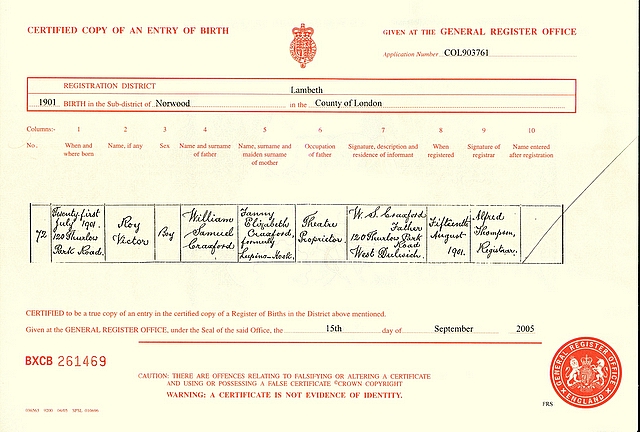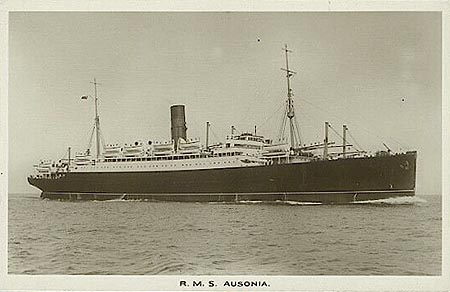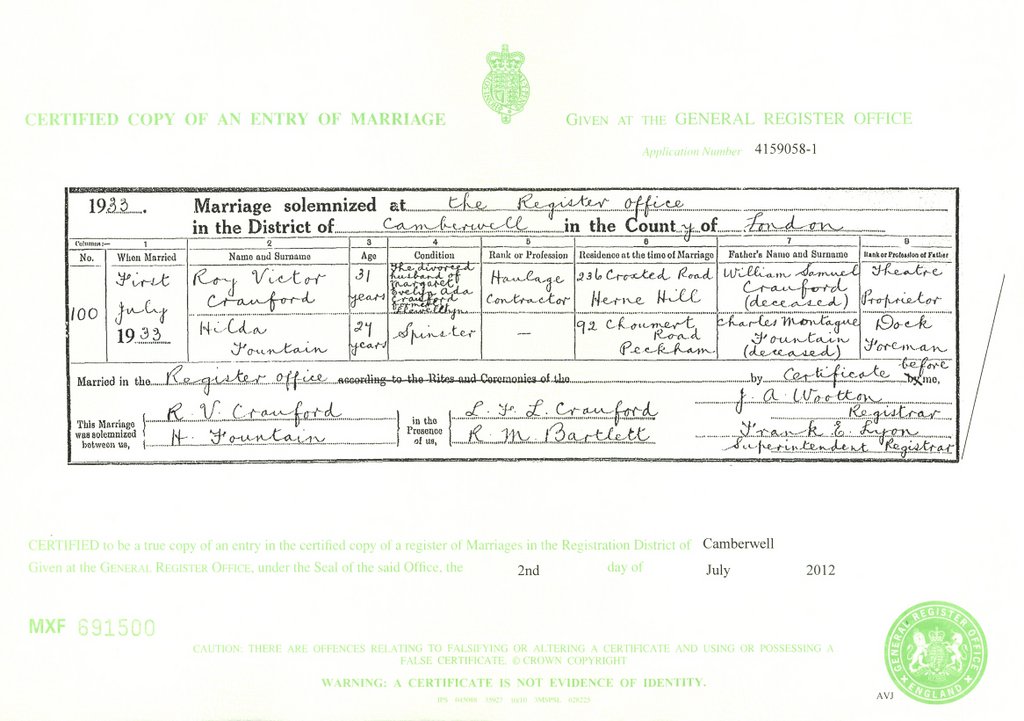
Navigation
Part C: Purple
- Back to Page 1:
Lane Crauford - Page 2: Craufords of Hoxton
- Page 3: Craxford / Cox
- Page 4: Crauford Credits
- Page 5: Letters
The Supplements

![{$text['mgr_purple1']}](../tng_placepurple.jpg) Britannia 6
Britannia 6
Roy Victor Craxford - "So come along and see me riding in the T.T. race" *
by Nick Smith, Samuel C. Craxford, Roger Bird and Alan D. Craxford
Introduction

Roy with his P.V. motorcycle
For more years than I care to admit, I have been restoring a couple of motorcycles made in London's Forest Hill: one in the 1910s, one in the 1920s. Part and parcel of this is finding out about those who made and rode them, one of those being R.V. Crauford. The recent Isle of Man T.T. motorcycle races jogged my memory, and I thought I'd see what the internet had to offer about such an unusually-spelled surname. I already had some contemporary press mentions and a few nice photos of him, but what else was there to find out? Imagine my surprise when there turned out to be an entire site, dedicated to Craufords, Craxfords and beyond... - N.S.
Our research into the Craxford family has never been straight forward. We have noted on many occasions the official mistakes, mis-spellings and voluntary variations in the presentation our surname. The London branch in particular frequently took to calling themselves Crauford although in official documents it was spelled Craxford. The subject of this study appears to have accumulated more variations than most, adding the alternatives, Crawford and Cranford, along the way. - A.D.C.
The story that has been passed down, at least in our branch of the family, is that one of our ancestors was completely opposed to the idea of any members of the family being involved with theatre life or appearing on the stage. It is said that my grandfather (or possibly great grandfather) changed the name to Crauford in response. - S.C.C.
Ancestors and the family
Roy Victor Craxford was born on July 21st 1901 in the Norwood district of Lambeth, London - an area where he would spend his whole life. He was the seventh child and youngest son of William Samuel Craxford and Fanny Elizabeth Lupino Hook, both of whom had a theatrical background stretching back over several generations. William, a publican and licenced victualler, had been born at the Britannia Theatre, Hoxton, North London and, with his brother Alfred Lane Craxford, ultimately became proprietor and owner of the establishment. The story is told in the article The Britannia comes to the Craxfords.
Fanny was one of at least thirteen of the children of George Hook. He was an actor and dancer at the Britannia Theatre and became well known in his day for his role as 'Harlequin' in pantomime. He appropriated the Lupino name from a family of fellow stage performers. Most of George's offspring became singers, dancers and performers at the theatre too. From this source, Roy Victor could claim kinship with a number of famous contemporaries including, from his mother's side, music hall star, Lupino Lane (first cousin) and film star, Ida Lupino (first cousin, once removed); and from his father's side, author W.H. Lane Crauford (first cousin), actress Mimi Crawford who became the Countess of Suffolk (his aunt's husband's nephew) and Hollywood actor Ronald Colman (uncle to the wife of one of W.H. Lane Crauford's sons).
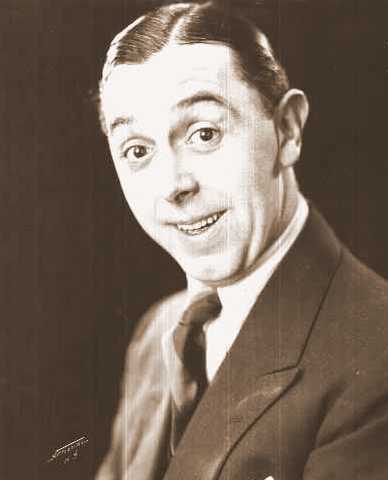




L to R: Lupino Lane (1), Ida Lupino (2), WH Lane Crauford, Mimi Crawford, Ronald Colman (3)
William married Fanny at St Giles Church, Camberwell on July 3rd 1878 when she was 18 years old. Her parents acted as witnesses. Their first six children, four boys and two girls, were born in Hoxton between 1880 and 1892. Last born of these, May Hope, died in infancy. Around the turn of the century, William moved the family south of the river to a large Victorian house in Thurlow Park Road, West Dulwich, which he called Britannia House, two doors away from the private Oakfield School. The family were still together in residence there at the time of the 1911 England Census and were able to employ two domestic maids. None of the children were destined to follow their father's occupation. First born, Samuel Alfred (born 1880), became a draughtsman for a gas company; Arthur Francois (born 1886) found work as an electrical engineer and Albert William (1881) and Percy Sydney (1891) became bank clerks.
A passion for motorcycles
Little is known of Roy's childhood. He attended Dulwich College, London, in 1914 and between 1915 and 1917 where his brothers, Arthur and Percy, had been students before him. He spent the academic year of 1915 at Shoreham Grammar School. It is known that he was not happy there, and was often taunted whilst young by threats of the being put on the "Shoreham, Worthing and Brighton train". Both his parents died whilst he was still a teenager: William in May 1914, Fanny in April 1916. William left the bulk of his estate to his wife but the 13 year old Roy was given a legacy of £1,500 which would be held in trust until his 25th birthday. Fanny had written her will in 1902 in which she made provisions that, in the event of her untimely death, her daughter, Lilian Fanny Lane Craxford, would become "guardian of my infant son Roy Victor". Lilian was 33 years of age when she assumed responsibility for the 15 year old.
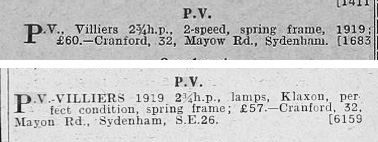
For sale ads
By 1918, Lilian and Roy were living at 32, Mayow Road, Sydenham, a house about 3 miles south east of their old address. He appears to have avoided conscription at the end of the first World War. We know from a small ad that Roy had bought, and subsequently sold a 1919 two-stroke motorcycle. This would have cost in the order of £70 new: quite a sum of money for someone just at the end of their teenage years. It seems likely that, even if she was not the driving force, Lilian was the facilitator for Roy's fascination with speed. At the top of the Mayow Road is Perry Vale, where, between 1910 and 1924, George Elliston and Sidney Fell ran their firm which made 'P.V.' motorcycles. All of their machines had a distinctive patented rear suspension system, or 'spring frame' in the terminology of the day. The P.V. works were local to Roy, being little more than half a mile from his home.

Motorcycles for sale
In April 1922, the 21 year old entered the London to Land's End Motorcycle Trial. This was one of the classic events organised by the Motorcycling Club and had been held on an annual basis since 1908. Over the years the conditions had been made more and more severe in order to keep pace with the increased speed, power and reliability of up-to-date motorcycles. That year the Trial had been made more difficult by the inclusion of one of the most arduous hill climbs in the country. The average gradient for the ¾ mile length of the hill was 1 in 7, with the steepest section of 1 in 3 (4). Inclement weather and gales added to the difficulties. Roy was one of 322 competitors. Wearing number 85, he was riding a 2¾ horsepower P.V. machine. There was no record of how he fared. However, he put it up for sale at the end of the month.
The following year, P.V. entered a machine in the Lightweight category of the Isle of Man T.T. races with Roy as their named rider. He was one of 41 competitors. He sustained two mishaps on the course, hitting the bank at Signpost Corner and bumping the bolster at Craig-ny-Baa. He finished in twelfth position, amongst the 22 survivors who completed the race, in a time of 4 hours 55 minutes and 36 seconds.
On July 1st 1923, Roy wrote a glowing testimonial which was reprinted in the 1924 season PV catalogue: "I feel I must write and congratulate you upon the machine I purchased from you and rode into twelfth place in the Lightweight Tourist Trophy Race, at an average speed of 46½ m;p.h. In all my experience of riding I have honestly never ridden a machine on which I felt so much at home. I also found that even at very high speeds, such as one attains down the mountain, the Spring Frame had a decided steadying influence. Please again accept my heartiest congratulations. R.V. CRAUFORD (Sydenham)"
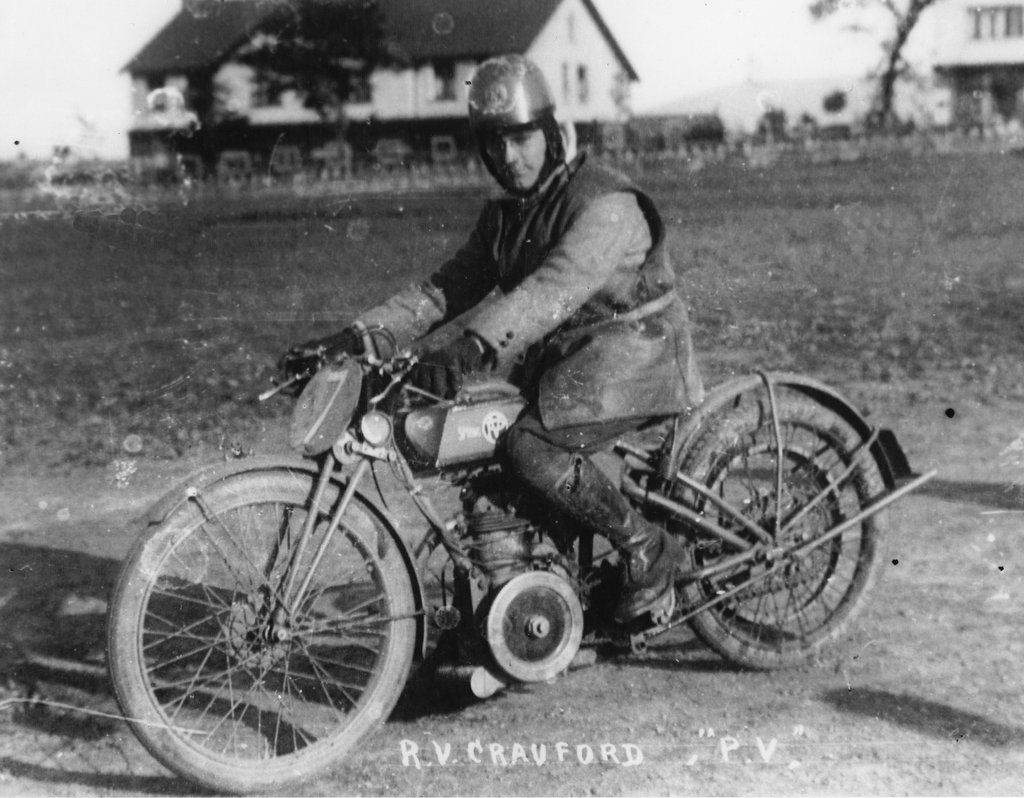
Posing with the motorcycle
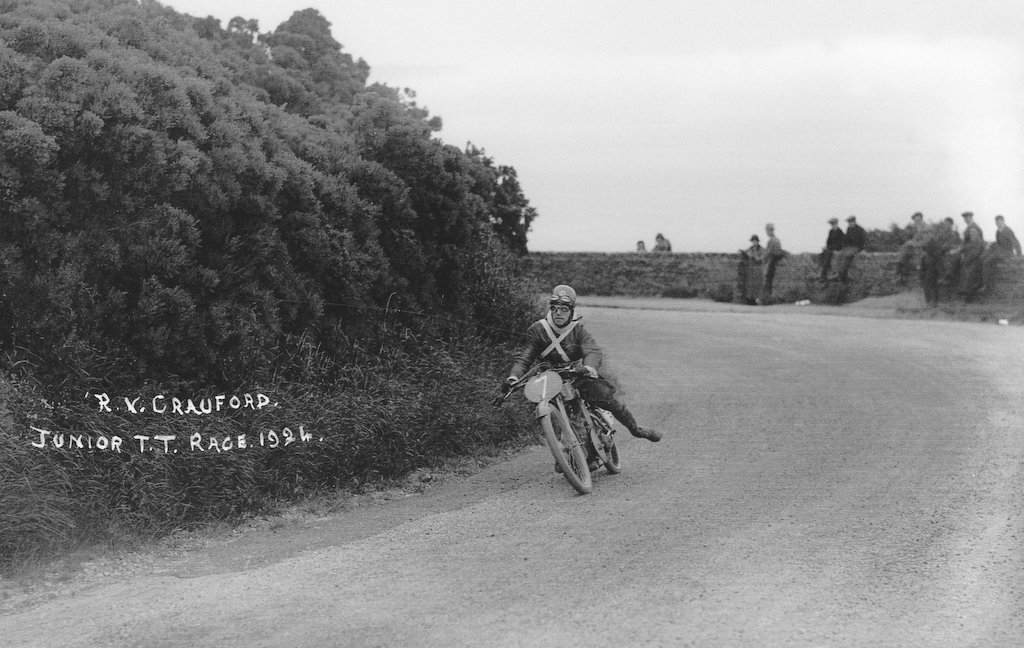
Roy in action
Roy was entered for the Junior T.T. event in 1924, again riding a P.V. machine - the only spring frame machine in the race. Wearing the number '7', he ended the third lap of six in fourth position in a time of 2 hours 1 minute and 21 seconds. At one point, he lost the stand to his bike and had to come into the pits minus a foot rest and trailing his left leg. He was ordered to retire on lap four because of the damage to his machine.
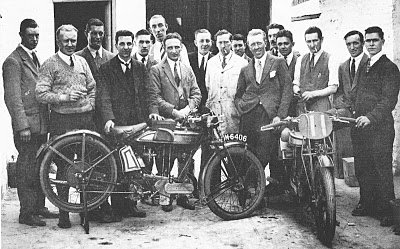
The 1925 Norton team
In 1925, he achieved his highest finish (11th) riding a Norton machine in the Senior race. In 1926, he rode O.K. machines in both the Junior and Senior races but was unable to complete either.
By 1927, Roy was now using an H.R.D. machine, manufactured by the company founded by Howard Raymond Davies. The entries for the 1927 Junior T.T. race were Freddie Dixon for the company and R.V. Crauford as a private entry. The practice sessions went quite well. Roy retired on lap five at Bray Hill, with brake problems, but Freddie Dixon and his machine performed flawlessly. Freddie went on to win the race at a record speed of 67.19 m.p.h. (5)
He is also known to have competed at the Brooklands circuit, Weybridge, Surrey. His first race was in a Preston & District club race (which despite its name was based in Brighton) on April 28th 1924. He finished second on a Sunbeam in the Amateur Solo race.
Of all the races on the Brooklands calendar during the 1920s, the 200 Mile solo race was regarded as the most prestigious and arguably the most gruelling. Roy was a private entrant on a Norton machine in the 1925 race just two months after his eleventh position finish on the Isle of Man. It appears though that he was injured during the practice sessions and was unable to start. The following year he entered again, this time on a works O.K. Bradshaw machine, finishing in eighth place. A month later, on an O.K. Supreme with a JAP engine, he finished thirteenth in the Hutchinson Hundred race.
During one of these races, he crashed his motorcycle on the railway straight. He recovered from his injuries but was left with a visible scar on his face. The Brooklands circuit was notorious for the bumps and uneven surface which were taken at high speed. At times the riders were flat on the tank for almost the whole of the lap. Such bumps were commonly the cause of facial injuries through contact with the steering damper or handlebars and a significant number of riders had false teeth as a direct result.
Records indicate that Roy didn't compete at the T.T. after 1927. However, the race remains as stiff a test of man and machine today as it was then, and Roy's achievements as an amateur entrant are highly commendable. Not only was he a serious rider capable of riding in a world class field but he also had a measure of works support even if not a full works rider.
Please contact us
 If you have any questions or comments about the information on this site in general, or you have further information regarding this article, please contact us at
Alan. We look forward to hearing from you.
If you have any questions or comments about the information on this site in general, or you have further information regarding this article, please contact us at
Alan. We look forward to hearing from you.
Added: August 1st 2012
Family life
There is evidence that Roy went out to Canada on at least two occasions in 1923 to seek work. He spent six weeks at the Queen's Hotel, in Montreal, in July and August that year looking at businesses connected with the mining industry. He set sail again from London on October 12th on board the S.S. Montrose bound for Quebec. He returned to London on the RMS Ausonia on November 14th.
In the spring of 1925, Roy married 21 year old Margaret Evelyn Ada Llewellyn at St Bartholomew's hurch, Sydenham. His brother, Arthur, and sister, Lilian, were witnesses. He had been living in Kirkdale, Sydenham next door to his future bride, prior to the wedding. He was working as a motor engineer. The marriage was not destined to last and was ended in divorce by the turn of the decade. There were no children.
In the early 1930s, Roy moved house to Croxted Road, just a few hunderd yards away from where his brother, Alfred William, was living with his wife, Daisy, and family. He married again on July 1st 1933 at the Register Office, Camberwell. His bride was 27 year old Hilda Fountain from Peckham, the daughter of a former dock foreman. The ceremony was witnessed by his sister Lilian. Roy described himself as a haulage contractor. Their son, Samuel, was born the following year.
At the outbreak of the Second World War, Roy enlisted into the Royal Army Service Corps. After initial training, he was posted to join the Army in France. He was evacuated from Dunkirk. He required a major surgical procedure, but after a period of recuperation he was sent to join the Army in North Africa. From there he became part of the occupation force in Italy where he was Mentioned in Dispatches.
Roy's sister, Lilian, never married. Records show that she continued to live at 32, Mayow Road until sometime after 1936. From there, she had moved to Thicket Road, Anerley, just south of the Crystal Palace Park. In 1944 she received a small bequest in the will of her uncle, Alfred Lane Craxford, who had died in Torquay that year. Roy was discharged from the Army on October 21st 1945. He moved the family to a house on Crystal Palace Park Road. He was again following the trade of motor engineer. In the late 1940s, Lilian moved into Parklands Nursing Home along the road from Roy's abode. She died in February 1950. She left her whole estate to Roy with the citation for his own use and benefit absolutely in recognition of his excellent voluntary services to our country and the wonderful help and comradeship he has given me.
Sometime towards the end of 1945, Roy's oldest brother, Samuel Alfred, was moved into the family's home. He had enlisted into the Army during the First World War where he had suffered severely from gas and shell shock. As a result of this he was essentially institutionalised on his repatriation to England. He lived with Roy for two years until he moved into a nursing home in Dartford where he died in 1949.
Roy's own health deteriorated during the 1950s with chest and heart problems. He found work as a night security officer. He was admitted to the Westminster Hospital where he died on November 30th 1961. He was 60 years old.
His wife survived him by over 30 years. Roy's son, Samuel, enlisted in the Army. He served abroad in the Far East with the 28th Company Gurkha Army Service Corps.
Some notes on the motorcycles
George Elliston of Clapham commenced trade as a cycle maker around 1906, and in 1910 he was joined by Sidney Fell, a motor engineer of Beckenham. In late 1910 they secured a patent (10,179/1910) for a rear springing (suspension) system, which they went on to use on all of the motorcycles they made. Rear suspension did not come into widespread use on motorcycles until the 1950s, so this really was quite an advanced feature for many years. Based in Perry Vale, Forest Hill (London SE23), they traded as 'Elliston and Fell', making machines under the P.V. marque. Their motorcycles were first announced to the press in November 1910, and they initially sold single-speed belt-drive bikes with different sizes of engine.
The works was variously located at numbers 93 and 72 Perry Vale (now both long gone), and finally number 1a Exchange Buildings from about 1915. This still survives: it's through an arch at number 174a Perry Vale, and is about the size of a double garage. They seemed to maintain quite a low profile in the contemporary press of the time. A 'small ad' seeking frame-builders in July 1914 possibly indicates an attempt to expand which was thwarted by WWI.
Like lots of manufacturers at the time, they bought in engines, carburetters, front forks and other fitments, and built frames to house them in. Before WWI, engine sizes ranged from a 500cc single-cylinder to a 976cc v-twin, all made by J.A.P. of Tottenham. For 1914, a flat-twin engine by ABC was an option, and coachbuilt sidecars were available. Frame lugs, wheels and related items likely came from Chater Lea in Clerkenwell. The range developed through 1912 and 1913, with the introduction of 3-speed hub gears, by Sturmey Archer and Armstrong. By mid-1914, they had started to fit Jardine countershaft gearboxes. It's likely that machines were largely built to order, so novelties could be adopted quickly, to keep up with prevailing trends in what was an industry still in its infancy.
The firm continued after the outbreak of WWI, offering just a 269cc two-stroke lightweight (using the popular Villiers engine), with a two-speed countershaft gearbox. By 1916, all non-essential manufacture stopped. Picking up in 1919, they continued with the lightweight bike in a slightly re-designed form, and gradually expanded the range to include more-or-less every size of engine, from 250cc two strokes, 350cc and 500cc four-stroke singles, and a range of v-twins from 500cc up to 1000cc. J.A.P. engines (made in Tottenham) were most commonly used, but engines by Bradshaw (made in Preston) and Barr and Stroud (Glasgow) were also listed. Burman gearboxes became the post-war standard. Around 1921, they became P.V. Motorcycles Limited.

The entry for the 1924 races
The T.T. entries are documented aside, and must have been quite an undertaking for a small firm. Each of the machines made was custom-built for the task: they bear no relation to catalogued models for the years in question.
It's not clear what happened after the 1924 TT - there are a couple of press reviews of bikes in the second half of 1924, but the edition of the Kentish Messenger dated 24/11/24 carries an advert for an auction of machinery, tools etc. for the company, which seems like the end of the road.
The Isle of Man TT Races [A]
The Isle of Man Tourist Trophy (T.T.) Races have been held since 1907, and they were born of the frustration of sporting motorcyclists of the time, whose enjoyment of this fledgling sport was hampered by various Acts of Parliament, which restricted their overall speed. The 'Red Flag' Act of 1896 (forcing all motor vehicles to be preceded by a man waving such an article at walking pace) was superseded by a 12 m.p.h. limit, and finally a 20 m.p.h. limit set down by the Motor Act of 1903.
While the basic design and function of motorcycles was still being defined, there's little doubt that, by that time, there were already those eminently capable of surpassing such modest speed limits. J.A.P. of Tottenham was already producing large capacity engines (including a monster vee-twin of 120mm bore and stroke, or 2,714cc), which enterprising cycle builders were fitting in lightweight frames, purely to see what speeds could be achieved. Everything was new: everything was up for grabs. However, domestic restrictions forced would-be speed demons to compete on the Continent, and as a result, the Governor of the Isle of Man had invited the RAC to stage a competitive event, which was the genesis of the T.T.
The first motorcycle T.T. was held on 28 May 1907, and in the early years, the St John's course largely avoided ascent of Snaefell mountain, which at 1300-plus feet would have been the match of the relatively-primitive machines of the day, which were generally on fixed-ratio belt drive, from engine to rear wheel. 1911 saw the institution of the 'Mountain course', and the division into classes by cylinder capacity.
It's worth bearing in mind that, apart from a stretch between Douglas and Ballacraine (a little over five miles out of more than thirty) and roads through Ramsay, the remainder of the circuit was comprised of dirt and cart tracks - dusty when dry, muddy when wet, and ridged and rutted either way. The roads were public roads, with stone walls, bollards and all other normal 'street furniture' lining them: the risk of injury or worse was a very real one.
Machines of the time, with rudimentary springing on the front forks, no rear suspension, and narrow-section tyres which needed to be run at high pressure to stay on the rims, were given a thorough work-out by six laps - as were their riders. 1914 saw the first of the rider fatalities.
The layout of the course was finalised in the 1920s, a lap now being 37.75 miles long, and most races lasting six laps - a total race distance of 226 miles. The race takes an unusual format in itself - it's a timed trial, the winner being the rider who completes his laps in the quickest time. While undoubtedly competitors would race each other on the roads, it was still the clock that they needed to beat. At the speeds of the day, a race might last four hours or more. The ritual of the 'T.T. week' was now set, competitors and spectators swelling the Island's population for the duration of practices and race week.
By the time Roy Crauford entered, average race speeds were around 50 m.p.h. upwards. Remember, that's an average over 226 miles, with first-gear corners, a punishing ascent of over 1300 feet from sea-level, other riders to avoid, and largely unmade roads, lined with unforgiving obstacles. A 37-plus mile lap takes a colossal amount of learning: corners which appear similar at modest speed are critically different at racing pace, and margin for error was minimal.
Roy's own recollection was that in his day, with a T.T. race being a push start, the throttle caused a number of incidents. The throttle only had two positions - idle and full. Thus a number of chaps were left standing after pushing since the bike roared off all on its own. The T.T. circuit was very hard on arms and hands, not only because of the terrible road surfaces, but also because of the bushes and other obstacles at the side of the road on many corners which did not like riders' hands being rushed through them at speed!
The races are still held today, although they have long been stripped of their status as part of any World Championship, on safety grounds. Those who take part are a different breed, even from the British and World Superbike riders, who enjoy smooth tracks, large run-off areas, air fences and the like. Road racers on the Island might hope for some well-placed straw bails, as they go between the houses in Kirkmichael at 180 m.p.h. The T.T. remains the ultimate road race, and as in 1907, it continues to be the ultimate test of man and motorcycle.
Surname notes
The spelling 'Craxford' appears on Roy's birth certificate and as legatee in his sister, Lilian's, will. His son, Samuel, was registered as Craxford at birth. This spelling has persisted with the branch to the present day.
He appears as Crawford in the index for his marriage to Margaret Llewellyn (although it is spelled Crauford in the register) and several editions of the 1930s electoral rolls
Father William gave the family name as Crauford in the 1911 census return. It is likely that Roy used this spelling in two small ads in 1920, although this was incorrectly transcribed in the typesetting as 'Cranford'. This was the name entered on his marriage certificate to Hilda Fountain. Roy raced as Crauford on the Isle of Man.
Roy's death certificate records his surname as both Craxford and Crauford.
Acknowledgements and further Reading
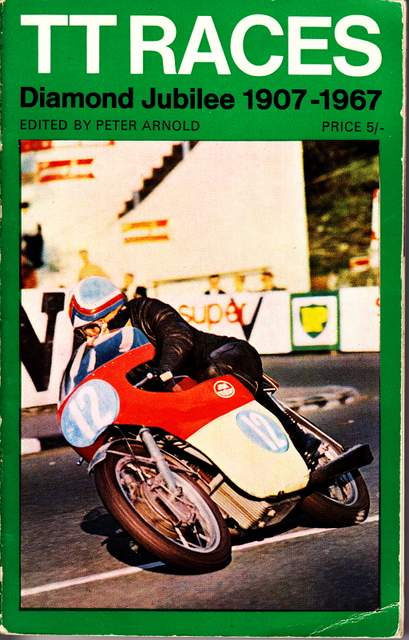
The book cover

The book cover
General chronological points for the section on the T.T. races above where checked and verified by reference to Peter Arnold's book: 'TT Races - Diamond Jubilee 1907-1967'.
Arnold, Peter: TT Races Diamond Jubilee 1907 - 1967: Shell-Mex and BP, UK: (1967). ISBN 978 1 84868 7202
Bird, Roger: A Glimpse of the Vintage Years of Motorcycling at Brooklands: Brooklands Museum (2008)
* We acknowledge the work of George Formby (1904 - 1961) as the inspiration for the title of this article. The song "Riding in the T.T. race" was featured in the 1935 film "No limit" which uses the actual event as a backdrop. A clip from the film of George singing the song in a railway carriage on his way to the Isle of Man is available on Youtube.
References
1. Lupino Lane publicity photograph: Fanpix.net
2. Ida Lupino biography: IMDb
3. Ronald Colman: biographical notes and publicity photograph: wikipedia
4. Land's End - A Classic in Part Three of the Gus Kuhn Story by Cyril May
5. HRD in Vincent History: Gary Keeling MyVincent website
6. "Bennett's 1925 Norton team - again" in Vintage Norton Motorcycles
Return to Top of Page
Translate this page:
Internet Beacon Diamond Site - 2010
© The Craxford Family Genealogy Magazine and individual copyright holders.Edited and maintained by Alan D. Craxford 2005 - 2024. All rights reserved. Contents may not be reproduced without permission.
You are not authorized to add this page or any images from this page to Ancestry.com (or its subsidiaries) or other fee-paying sites without our express permission and then, if given, only by including our copyright and a URL link to the web site.















